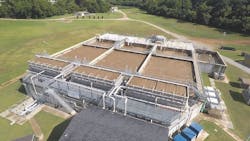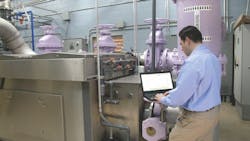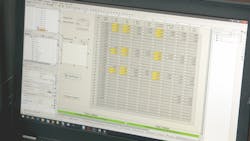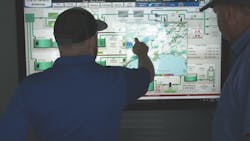About the author:
Jim Meyers is success manager for Inductive Automation. Meyers can be reached at [email protected].
The city of Decatur, Arkansas, wanted to increase capacity at its wastewater treatment plant. It also needed a new system for supervisory control and data acquisition (SCADA). Not shy about using advanced technologies, the city now has the first membrane bioreactor (MBR) wastewater treatment plant in Arkansas. It also has a robust, modern SCADA system that provides more data access, analysis and reporting for its processes.
The city increased capacity from 2.2 million gallons per day (mgd) to 4.6 mgd by changing from a sequencing batch reactor (SBR) to the MBR. The retrofit project more than doubled capacity while keeping the same-size footprint. It was commissioned in January 2019.
On the MBR project, the city worked with H2O Innovation, a customized water and wastewater treatment solutions company with membrane technologies. H2O is based in Quebec City, Canada, and has numerous locations around the world. For the SCADA upgrade, the city worked with both H2O and system integrator Automation Station, which is based in McAllen, Texas. Automation Station provides industrial software and hardware solutions for the water and wastewater, food and beverage, manufacturing and automotive industries.
H2O and Automation Station built the new SCADA system on Ignition by Inductive Automation—an industrial application platform with tools for building solutions in SCADA, human-machine interface (HMI), and the Industrial Internet of Things (IIoT).
“The city had two key problems it wanted to solve,” said Paul Bartlett, automation and controls manager for H2O Innovation. “First, it wanted to increase the size of the plant, to accept additional waste from neighboring communities and from an additional industrial source. Also, it wanted to upgrade its antiquated controls system. It didn’t have data logging, reporting or trending. Ignition was able to do all three.”
Both the new SCADA system and the MBR have been improvements for the city.
“This membrane system is exactly what we needed,” said Bob Tharp, mayor of Decatur. “We’re the first membrane plant in the state of Arkansas, and I know we’re going to lead many other cities in the state as we share our success.”
Open-source MBR Design
A big factor in H2O being selected for the MBR project was the company’s flexMBR design. The flexMBR open-source design allows any of several membrane manufacturers’ products to be used. This helps the city financially because it is not locked into using a specific type of membrane. Whenever it is time for a replacement, the city has numerous options from which to choose.
This modular approach also means that the MBR is open to new module designs that will be developed in the future. Parallel trains can operate with different membranes within them; they do not all need to be the same. The city has five membrane modules in each of its three trains, with space for a sixth module in each as well.
Because MBRs have a semi-permeable membrane that completely retains activated sludge, they have separate control of the solids retention time (SRT) and hydraulic retention time (HRT). An MBR operates at a higher biomass concentration, and the bacteria are older due to a higher SRT, which accelerates digestion. MBRs separate solids using a physical barrier, so effluent quality is not affected by process upsets compared to other activated-sludge processes which rely on secondary settling.
With the effluent quality from its new MBR, the city’s plant is now in compliance with its discharge permit and is meeting more stringent nitrogen limits. The new controls system allows the operators to have precise control of their sludge wasting, which is directly related to the SRT. The city can now schedule wasting automatically instead of relying on manual operation.
For the MBR retrofit, nearly all the existing infrastructure was leveraged. The SBR basins were converted into continuous flow reactors, return activated sludge lines were added and steel membrane tanks were installed on top of the existing post-equalization tank.
The new design includes submersible pumps that send mixed liquor up to the elevated membrane tanks; it overflows back to an anoxic zone. The existing jet aeration system continues to send mixed liquor forward into an aerobic zone. A third jet aerator was installed in each train to ensure sufficient oxygen transfer capabilities. An existing anaerobic zone located at the front of each train was kept in service, leading to a treatment train that is similar to the University of Cape Town (UCT) process.
Energy Savings
On this project, H2O Innovation worked to bring down energy costs for the city.
“The project included a high degree of focus on energy optimization that was achieved through three key initiatives, all of which rely heavily on controls,” said H2O’s Bartlett. “For the city to quantify and understand the benefits of energy savings measures, we implemented an energy savings monitoring system.”
The three key systems are siphon mode, sleep mode and blower optimization. The siphon mode flow control system minimizes pumping of treated effluent. Since the process tanks are elevated, the pumps can be bypassed, and a control valve can be employed to control flow.
Sleep mode occurs during low-flow periods, allowing one or two process trains to stop receiving flow. Instead, they go into a sleep state where all equipment is operated at minimum energy. The third energy-saving system involves process blower optimization through dissolved oxygen control. Instead of operating the process blowers at a constant speed, they adjust speed and turn on and off as needed to minimize energy usage.
Energy savings from these three systems are calculated by considering the energy costs that would have been experienced without having the systems in place. Energy consumption is tracked in real time, and reports demonstrate the savings.
A New SCADA System
The new SCADA application includes monitoring, controls, historian, reporting and a custom database. It gives the city access to much more data than it had in the past, and it makes it easy to do reports based on that data. It also allows operators to enter lab data manually. City staff can now see data trends that previously went unnoticed. The city can compare lab data side-by-side with live process data. Operators use this to ensure the plant is meeting effluent requirements during increased influent flow, such as storm events.
The city has seen numerous benefits from the new SCADA system. A key feature is the unlimited licensing for Ignition—meaning there are no extra costs for more tags, devices, users or projects.
“The unlimited licensing allowed us to give access to the mayor of Decatur, as well as utility directors of neighboring cities,” said Bartlett. “This allows them to make real-time business decisions based on live data.”
Mayor Tharp also appreciated the power of data at the plant.
“Data coupled with insight drives you to an action process,” he said. “That is a core belief of mine. When we looked at Ignition, we found a huge amount of data, reliable data, and consistent data. And we took our insight, which is our people’s time on the job, and then that drove us to good action plans.”
Plant operators also like the new system, particularly how all data is accessible in one spot, even when working remotely.
“Now we can operate the plant from one central location,” said James Boston, chief operator and public works manager for the city. “I can even operate it from my house, on my laptop. We have a complete picture of what’s going on at the plant at all times. It’s real-time data and real-time alarms. Everything is right there on the screen.”
Big Step Forward
“Before we upgraded their control systems, the operators were using pen and paper to log all their data and storing it in file cabinets,” said Bartlett. “Now they’re visualizing this data. And they’re using it for trending, reporting, graphing. It all saves time and money.”
The software also helped the project with speedy development.
“We worked with H2O Innovation to develop objects in the PLCs,” said David Rojas, chief automation engineer for Automation Station. “Then we tied those over to user-defined types (UDTs), which helped simplify the development of the entire application. Even though there were 14,000 tags, we were able to manage them efficiently using those UDTs.”
The SCADA system also brought in live weather information.
“The city really liked being able to pull in weather data,” said Rojas. “We used Ignition to grab real-time information from the National Weather Service and plot that information stored in the historian.”
Using the weather data, operators can ensure normal operations during storm conditions. It helps the city collaborate with utilities from other cities to divert water and avoid overflows.
Now that the new SCADA system is deployed, the plant can accept waste from a commercial factory that needs real-time data to meet its regulatory obligations. And the city of Decatur now has more data than ever before from its wastewater treatment plant.
“The Ignition project connected all our different control systems into one central network,” said Boston. “In the past, we had to go gather information, and we had to put it all together. Now, all the information is in one central location.”



